The Melbourne version of old folks’ home For 4 year olds
Bringing society’s oldest and youngest members together has proven benefits like lifting depression and enhancing social skills. Here’s how one Melbourne daycare is introducing little people to big friends.
Lifestyle
Don't miss out on the headlines from Lifestyle. Followed categories will be added to My News.
Ollie, 3, is on the couch “reading” a well-worn copy of T he Very Hungry Caterpillar to 76-year-old Willie Oakes, who is sight-impaired.
Atlanta, 5, and Bruce Bowman, 82, are picking out colourful plastic pins from a basket and sticking them in a peg board.
And identical twins Penelope and Wilhamina, 3, have taken a break from activities for cuddles with grandmother Chuan Jiang, 84.
At first glance, these visits are all about fun and games with willing new playmates who just happen to have all the time in the world for making playdough hotdogs or pottering in the vegetable garden.
But there’s something much deeper at play here.
Bringing society’s oldest and youngest members together in this way is part of the new-to-Australia phenomenon of what’s called “intergenerational learning”.
While children have been visiting aged-care centres for decades, what’s new in intergenerational learning is the focus on ongoing, interactive, relationship-building activities.
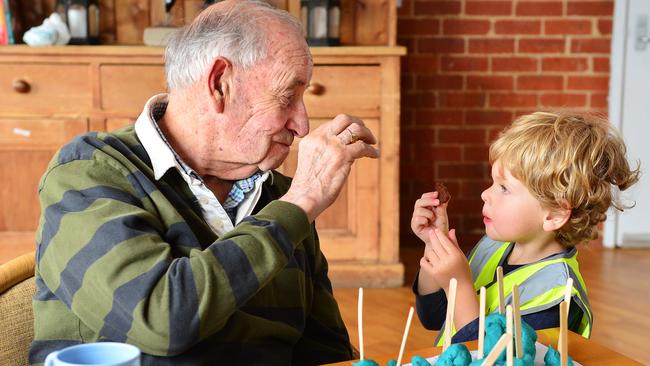
The kindergarten children from Port Melbourne’s Little Patch Early Learning Centre walk to nearby South Port Community Residential Home in Albert Park every fortnight to visit the residents, building friendships while engaging in one-to-one activities.
It’s an idea that took off in Europe and the US several years ago, long enough for research into the mutual benefits to be undertaken with remarkable results.
For the elderly, it’s been proven to lift depression, relieve loneliness and social isolation, improve cognitive skills, self-esteem and wellbeing, and give a sense of purpose in life.
And for the children, it’s been shown to improve communication and social skills, such as co-operation and teamwork, and provide a sense of community and care for others.
Remarkably, intergenerational learning at a young age has even been found to reduce rates of delinquency as the children grow up.
Little Patch managing director Michelle Clarke introduced the visits in July, and was astounded at the initial reaction when the two groups met.
“Our first visit was the most beautiful thing I’ve ever seen,” Clarke says.
“I was expecting a little bit of awkwardness — these children have never met these people before. Some of the residents are obviously immobilised and some of them have speech issues, so I was expecting the children to be a little bit cautious in their approach.
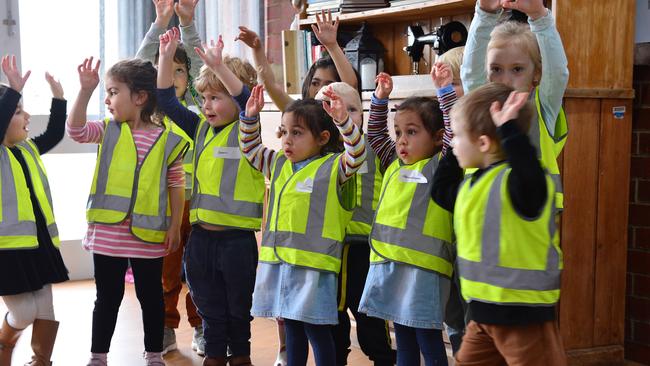
“And it was the complete opposite of that. From the second they walked in there, they were just so engaging with the residents. I was really quite taken aback by how engaged the children and the residents were with each other.
“There were no inhibitions, no awkwardness.”
Human contact is an important part of the experience, and hugs are never in short supply.
“We’ve got some residents who, if you walk straight past them, they grab your leg and cuddle you,” Clarke says.
“And there’s one particular lady who, if you’re within grabbing distance, she’ll grab you and hug them to death.
“There are others who are observers — they just sit there and observe. So you’ve got this whole range of personalities across the residents and the children, but you start to see now that some children gravitate towards some residents, so there’s little friendships developing.”
Vicki Fraser, the home’s lifestyle manager, says the program brings out the best in her residents because of the children’s innocence.
“The majority don’t have any fears, so they’re more than happy to go up and give them a big hug,” she says.
“If the residents put their arms out, the little ones will just jump into their arms.”
Fraser is amazed at the friendships that have already formed in such a short time, and says seeing her residents so full of joy is heartwarming.
“A lot of these residents now don’t have the opportunity to see their grandchildren for all different reasons,” she says.
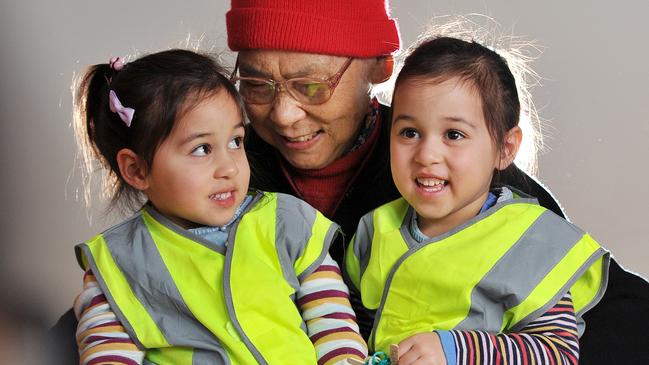
“They could be interstate or overseas or they aren’t talking any more, and this is why having the children come in is so important. It’s a win-win situation.”
Fraser mentions one resident with learning difficulties who can be “a little bit grumpy”.
“But now, with the students, she’s actually really mellowed,” Fraser says.
“We’ve said to her, ‘It’s a good opportunity for you to be able to teach these children’, so this has been lovely for her to be able to help them.
“She looks forward to it, and she wanted to get her hair done yesterday before the visit, and get dressed up.
“They all dress nicely every day, but some of them want to make it special when the kids are coming, and that’s really important.”
The kindergarten teachers carefully plan the activities they’ll bring to the centre.
Sensory activities such as playdough are always a hit, as are puzzles, drawing and blocks.
On ourvisit, the children give an energetic rendition of a song they’ve been practising, You Are My Sunshine, with piano accompaniment, much to the delight of residents, including Barb McGovern.
“I love to hear them singing,” she says. “It makes me feel happy.”
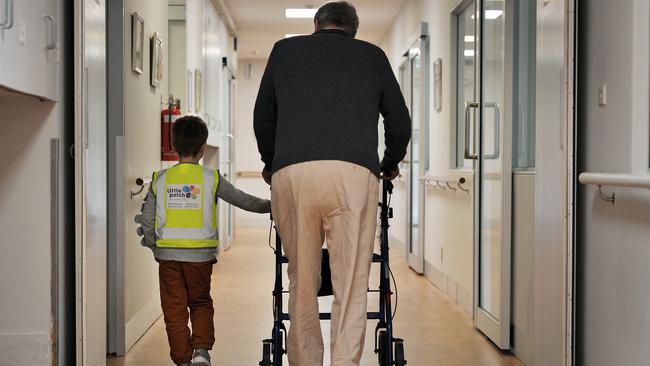
McGovern, 80, says she looks forward to having the children visit — “and they look forward to seeing me”.
And while the children have only visited a few times, it’s evident she sees them as more than merely occasional drop-ins when she adds: “I’ve made quite a few friends.”
For Willie Oakes, who rarely has visitors because his children and grandchildren live interstate and overseas, the children’s visits are a highlight.
“They brighten up the day,” he says. “They read me books.
“It’s sleepy time, really, when there’s no children here. One does (sleep a lot), you know.”
It’s no coincidence intergenerational learning programs are emerging at this time.
In the past, there was little need, because children generally had close relationships with their grandparents, and elders tended to remain in or near the family home.
READ MORE
AUS BALLET DAVID McALLISTER’S INCREDIBLE LEGACY
HOW JOBE WATSON’S NY ESCAPE CHANGED HIS LIFE
MIDLIFE CRISIS REPLACED WITH MIDLIFE TRANSITIONS
By contrast, Clarke says many of the children do not have their grandparents around. Likewise, many elderly residents do not receive visitors regularly, if at all.
“That is a sad aspect of some of those facilities,” Clarke says.
“There is a large portion of residents who either don’t have family or the families don’t visit them, so they may have grandchildren but they don’t see them, which is really sad, but I think we fill that gap a little bit, too.”
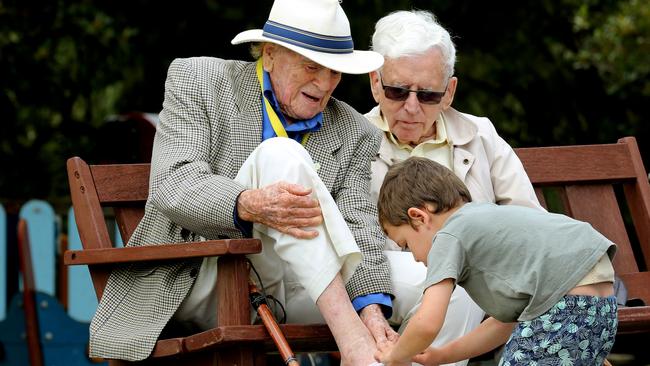
Intergenerational learning is firmly in the spotlight after the recent hit ABC TV series, Old People’s Home For 4 Year Olds, a heartwarming experiment that showed how a group of children transformed the lives of a group of seniors in a Sydney retirement community.
A team at Griffith University in Queensland has also been researching the emerging field for the past two years, with promising results.
Research fellow Dr Xanthe Golenko and her team have just completed a Federal Government-funded two-year study that involved developing, implementing and evaluating intergenerational learning programs at four locations in NSW and Queensland.
“What’s really important here is that it’s an intergenerational learning program, because there are different types of intergenerational programs,” Golenko says.
“An intergenerational learning program is really designed around a high level of engagement and interaction between the generations. It’s really actually doing activities together.”
Golenko says the two age groups — older people and young children — work well together. “Older people and children don’t have any filter,” she explains.
“They say what they want and they do what they want when they want, and that is kind of special as well.
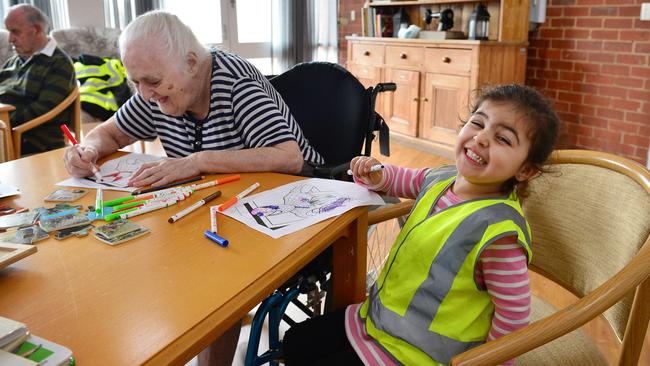
“And the older people generally don’t let the children get away with things. For example, if they’re playing games, the older person will make sure they each get a turn. They won’t let the children do whatever they want and rule the roost.
“It really does become an equal bond between them.”
The study also found intergenerational learning improved children’s attitudes towards older people and ageing, which Golenko says would stay with them as they grow up.
“Having that positive interaction at a young age is really important, because we have issues around ageism,” she says.
“And intergenerational programs have been shown to reduce delinquency in children as they get older, so that interaction is really important.”
As for the future of intergenerational learning, having seen how successful her program in Melbourne has already been, Clarke hopes to see the idea spread in Australia.
“I can see this being rolled out on a larger scale, because the benefits are so enormously beautiful,” she says.
“And, yes, there are logistics to it … but it’s worth it, because it’s the most beautiful program.”
